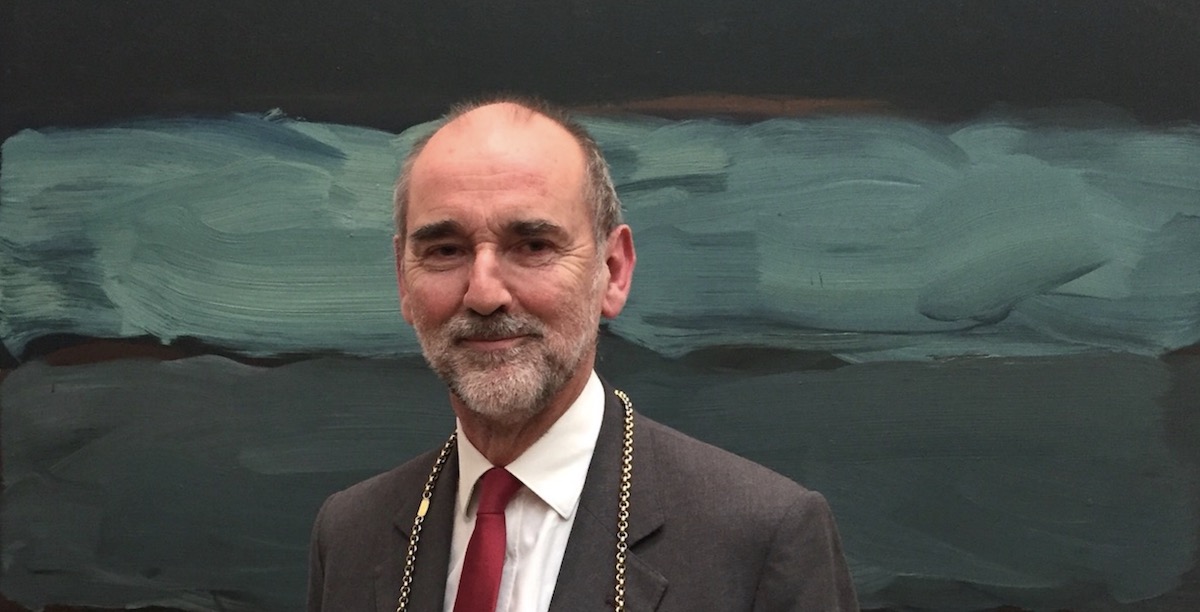Christopher Le Brun has been selected as the new president of the Royal Academy of Arts. He is the 26th president in the academy’s 243-year history and the first painter to be chosen in 20 years. Le Brun follows notables such as John Everett Millais, Lord Leighton and Joshua Reynolds and hopes his tenure will help foster an atmosphere of vigorous debate and intellectual risk.
The election took place on Thursday night,. “I felt quite strongly that, for the wellbeing of the academy, it’s right for there to be proper rotation between the categories,” he said. “Dearly as I love the architects, who are tremendously efficient at this sort of thing, some painters can also do the job.” He succeeds architect Nicholas Grimshaw at an important crossroads for the academy, which has ambitious plans to expand its central London premises into the building at 6 Burlington Gardens, the former Museum of Mankind which is currently leased by the Haunch of Venison gallery.
Born in Portsmouth in 1951, Le Brun studied at the Slade School of Fine Art (DFA) London from 1970-74 and at Chelsea School of Art (MA) from 1974-75. He has exhibited in many significant surveys of international art, including Nuova Immagine, Milan 1981, Zeitgeist Berlin 1982, Avant- garde in the Eighties, Los Angeles 1987 and Contemporary Voices, Museum of Modern Art New York 2005, Watercolour, Tate 2011. From 1987-88 he received the D.A.A.D. award from the German government, living and working in Berlin for a year. Le Brun is a former trustee of Tate, the National Gallery, and the Dulwich Picture Gallery. He is currently a trustee of the Prince’s Drawing School. In 2010 he was awarded an Honorary Fellowship by the University of the Arts London. He is a Painter, Sculptor and Printmaker and his work is in many national and international collections including those of Tate, The British Museum, V&A and MOMA, New York.
Le Brun wants to see a return to the sort of memorable exhibitions such as New Spirit in Painting (1981), Sensation (1997) and Apocalypse (2000). “I think the academy is very well placed to show major exhibitions of, say, painting or sculpture,which establish a new movement or put us in touch with what’s going on. These exhibitions are very difficult to put on and they need serious research but I think it is the sort of thing the academy can do very well.”
His election by academicians followed the process established by a constitution that predates the American constitution. He beat out Stephen Farthing, John Maine, Spencer de Grey and Ian Ritchie after four rounds of voting involving 84 academicians. When Le Brun finally won 50-33, the RA’s secretary and chief executive Charles Saumarez Smith was obliged to call Buckingham Palace as required in the RA constitution.
Le Brun now wants to see younger artists and architects elected to the RA. “Something has definitely happened in my time here. It has become the sort of place that artists now don’t think twice about wanting to be part of. When I was a young painter, the academy didn’t really exist for me… the academy did not seem essential to my profession.”
The President is Chairman of Council, which provides direction to the General Assembly, the governing body of the Academy which represents the Membership. The Membership comprises 80 Royal Academicians, all of whom are practising painters, sculptors, engravers, printmakers, draughtsmen and architects, as well as a number of Senior Academicians over the age of 75. The of the Academy as an institution governed by its Members and not dependent on any public funding means that the President represents the only body able to speak with consistent authority in defence of art and artists in this country.
Top Photo: © Artlyst
Past Presidents of the Royal Academy
Sir Joshua Reynolds 1768–1792 Sir William Llewellyn 1928-1938
Benjamin West 1792–1805 Sir Edwin Lutyens 1938-1944
James Wyatt 1805-1806 Sir Alfred Munnings 1944-1949
Benjamin West 1806-1820 Sir Gerald Kelly 1949-1954
Sir Thomas Lawrence 1820-1830 Sir Albert Richardson 1954-1956
Sir Martin Archer Shee 1830-1850 Sir Charles Wheeler 1956-1966
Sir Charles Lock Eastlake 1850-1865 Sir Thomas Monnington 1966-1976
Sir Francis Grant 1866-1878 Sir Hugh Casson 1976-1984
Lord Leighton 1878-1896 Sir Roger de Grey 1984-1993
Sir John Everett Millais 1896 Sir Philip Dowson 1993-1999
Sir Edward J. Poynter 1896-1918 Professor Phillip King 1999-2004
Sir Aston Webb 1919-1924 Sir Nicholas Grimshaw 2004-2011
Sir Frank Dicksee 1924-1928

